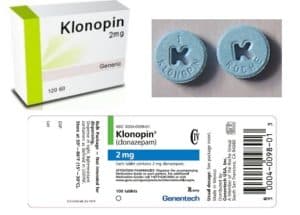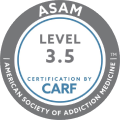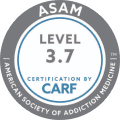
Klonopin is a drug that belongs in a class of drugs known as benzodiazepines, which are generally considered to be sedatives. Klonopin works by calming the brain centers and nervous system, and for that reason, it is popularly used by physicians to treat seizures, convulsions, and epilepsy symptoms. It is also sometimes prescribed for individuals who suffer from anxiety disorders and panic attacks.
Unfortunately, Klonopin also has a reputation for being potentially addictive. Worse, addiction issues aren’t always detected until a patient is moved onto a different drug. Also, there are significant overlaps between the symptoms of the conditions Klonopin is designed to treat and the withdrawal symptoms that come with it.
Foremost, you should be aware that quitting Klonopin cold turkey and without proper professional supervision can be downright dangerous. It is possible for a person to die due to withdrawal symptoms arising from the use of any benzodiazepines, and there is also a significant risk of suicide during the withdrawal process.
Getting off benzodiazepines is an involved process. Let’s take a look at what you can expect in terms of side effects from the drug itself, withdrawal issues, and the detox process.
Prescribed Usage of Klonopin and Side Effects
Everyday use of Klonopin, also known as clonazepam, is usually prescribed for patients to be consumed two or three times a day. Dosing will vary based upon the age of the patient and his or her weight. In some cases where side effects seem to be creating trouble for patients, the dose may be lowered. Regardless of your situation, you should alter your intake unless directed to do so by your doctor.
Clonazepam is classified as a fast-acting and high-potency benzodiazepine. This makes it appealing as an option for treating individuals who are having seizures, panic attacks, or anxiety issues that need to be shut down as soon as possible for medical or practical reasons. It also takes a long time to leave the system, meaning it will also continue to deliver some desired effects for days.
Like many other kinds of benzodiazepines, Klonopin is known to have side effects like drowsiness, dizziness, and unsteadiness. A person may also experience:
- Dry mouth
- Sore Gums
- Memory and cognitive issues
- Runny nose
- Decreased appetite
- Diarrhea
- Constipation
- Blurry vision
- Headaches
Doctors do not recommend breastfeeding while on this drug. Likewise, some doctors encourage mothers to discontinue use during pregnancy.
How Klonopin Works
Excessive activity of the gamma-aminobutyric acid neurotransmitter in the body can trigger a host of issues. These include forms of sleeplessness, seizures, and anxiety. Notably, common sedatives like Klonopin do not change the GABA levels in any way. Instead, they’re designed to bind to the GABA receptor, ensuring that it won’t have the same stimulating effect it would have if left unimpeded.
This process is considered subtler with benzodiazepines than it is with an older class of sedatives known as barbiturates. Relative to problems from barbiturates, benzodiazepines are generally considered safer due to their lower interactivity with other types of drugs, especially alcohol. This is not to say, however, that consuming benzodiazepines with alcohol is safe. It merely means that it is less risky than with other prescription options.
GABA is the single most common neurotransmitter seen in the human nervous system. GABA levels are known to play a role in disorders like Parkinson’s disease and Huntington’s disease, and there are types of drugs specifically designed to drive up GABA levels in these patients.
Synapses that utilize GABA in your brain number in the trillions. These are proteins that function in highly mechanical manners to trigger events, to transfer substances, and to regulate the overall functionality of your nerves, spinal cord, and brain neurons. GABA, however, is predominantly present in the brain.
Where GABA interacts with drugs like benzodiazepines are in ensuring that certain nerve activities are cut off. For this reason, it is considered to be an inhibitive neuroreceptor. If these receptors refuse to shut off or don’t receive enough GABA to fully close down their activities when necessary, it can give rise to disorders like anxiety and sleeplessness. In extreme cases, an individual can even suffer seizures.
Benzodiazepines also absorb well through the gastrointestinal tract, making them desirable for delivery in oral form by pills. Likewise, GABA receptors have what is scientifically called an affinity for benzodiazepines, meaning these receptors readily take up the drugs.
Ultimately, this interaction ensures that many doctors will continue to reach for benzodiazepines in treating patients. It was estimated that as of 2007, more than 112 million Americans had been prescribed some type of benzodiazepine. This makes it one of the most widely prescribed classes of drugs in American history.
Symptoms of Klonopin Withdrawal
The list of possible withdrawal symptoms related to quitting Klonopin or to reducing one’s dosage is fairly long. Physical issues can include:
- Muscle spasms
- Nausea
- Sweating
- Heart palpitations
- Fatigue
- Seizures
- Insomnia
- Hand tremors
It may be tempting to assume that some of these issues are related to the conditions the drug is used to treat, but individuals who are not being treated for seizures, for example, have experienced them during the withdrawal process. There can, however, be relapses of conditions being treated, too, as the nerve firings begin to pick up.
Mental and emotional withdrawal symptoms can occur, too. These include:
- Nightmares
- Panic attacks
- Depression
- Hallucinations
- Mood swings
- Irritability
- Memory trouble
- Suicidal thoughts
Fatalities have been recorded during the withdrawal process as have cases of comas. This is especially the case when individuals were using opioids at the same time.
It is also possible for seizure-related deaths to occur when individuals who have pre-existing seizure disorders begin to experience the re-firing of the nerves and brain centers that are triggering their seizures. In some instances, this can give rise to grand mal seizures. It is for these reasons, in particular, that individuals trying to get off any of the commonly prescribed benzodiazepines are encouraged to only do so with the guidance of a qualified professional.
Detox From Klonopin
The half-life of Klonopin in the bloodstream is between 18 and 50 hours. The variation is due to the fact that different people’s bodies metabolize and expel this drug at different rates. Doctors also frequently encourage patients to build quantities of Klonopin up in the bloodstream over the course of weeks.
Let’s take a moment to think about how the half-life works. Basically, it means that in a patient who experiences a 24-hour half-life on a 1-milligram dose, that person would have:
- 0.5 milligrams in their bloodstream after 24 hours
- 0.25 milligrams after 48 hours
- 0.125 milligrams after 72 hours
In other words, even though a lot of the dose will exit your system, you can still expect a small amount to stick around for a fairly long time after you’ve taken your last dose.
This isn’t the worst of all possible situations, though. Doctors generally prefer to wean people off benzodiazepines. On the downside, though, withdrawal symptoms may not be evident to someone who has gone off a drug like Klonopin until after a few days have passed.
Often, as long as the drug has some degree of effectiveness, withdrawal doesn’t start. Among people who have ditched the drug cold turkey, this can make it seem that everything is going well and that there is nothing to worry about; however, withdrawal has been proven fatal when not properly tracked.
During a structured detox process, it’s important to be upfront about any other drugs you’ve been using. This includes any street drugs you’ve used. The interaction of benzodiazepines with alcohol and opioids, for example, is especially tricky to deal with. People also frequently end up dosing themselves more than they should.
It is strongly advised that you do not go off Klonopin without the support of someone who knows how to handle a detox. Foremost, you need to inform the professionals assisting you with the amount that is in your system. If necessary, check the labels on pill bottles to ensure that you’re providing as accurate a picture of dosing as possible.
You should also be acutely aware that it can be challenging for professionals to differentiate whether a symptom is the product of withdrawal or if it is related to an existing condition. Try to, if possible, provide as detailed of medical history as you can. This will help the people involved with the detox to determine whether something like a seizure is arising from the withdrawal process or from your condition.
Choosing a Detox Program
A medical detox of Klonopin will take between five and seven days from the time that withdrawal symptoms hit their peak. Some folks may exhibit limited signs of withdrawal for up to a month. Your metabolism will dictate how long it takes to get to that peak.
It cannot be stated strongly enough the importance of at least beginning the process in a facility that provides 24/7 care. While this is often the most expensive way to handle detox, the necessity of having nurses on call at all times and a crash cart available makes it the preferred choice. Should withdrawal become too challenging to cope with, it is possible for your doctor to stop weaning you and to up your dose during the tapering process. They will then resume tapering at a slower pace.
Notably, you will still have the disorders that the drug was originally prescribed to treat. For someone dealing with severe seizures, for example, this means that you will need to work with a practitioner to find another treatment option.
If you’re coping with other issues, such as using drugs or alcohol alongside Klonopin, you should look for facilities that offer dual-diagnosis programs. In addition to tapering intakes, some professionals will also prescribe drugs meant to take the edge off from benzodiazepines. Those concerned about relapses should discuss how comfortable they are with this approach before entering into a program.
Benzodiazepines have an earned reputation for being hard to kick. According to one study, only about half of users of benzos like Klonopin will remain completely abstinent after 100 days. In other words, there’s a fairly high risk of relapse occurring. Not surprisingly, this risk is higher among people who have been on strong doses and those who have been abusing the drug. This is also the case with individuals who have histories of substance use disorders and those from families with such histories.
More than anything, it’s important to remain persistent, even in the face of a relapse. Your goal should be to get healthier, and that will take time.






